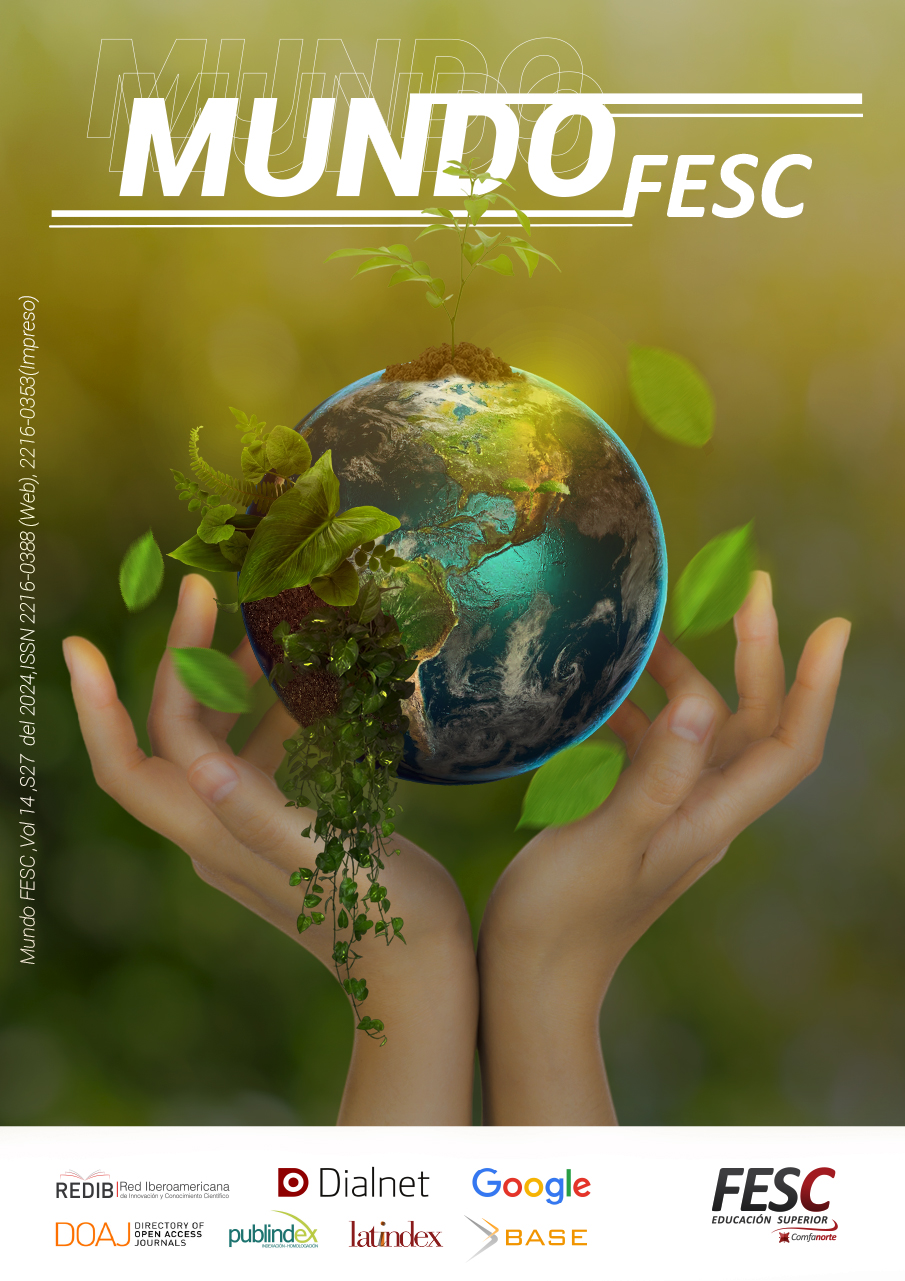Análisis de películas biopoliméricas de almidón para potencial aplicación en optoelectrónica.
DOI:
https://doi.org/10.61799/2216-0388.1591Palabras clave:
Biopolímero, Almidón, Plantas acuáticas, Dimetilsulfóxido, Optoelectrónica.Resumen
La investigación de materiales energéticamente eficientes, como las perovskitas, ha experimentado un aumento debido a que por sus características, bajo costo y variedad de métodos de obtención, se pueden desarrollar dispositivos optoelectrónicos. Sin embargo, su susceptibilidad a la inestabilidad cuando se exponen al aire, la humedad o variaciones de temperatura ha motivado la búsqueda de estructuras alternativas que utilicen materiales sostenibles, buscando así mejorar su durabilidad, optimizar la fabricación y reducir costos. En este contexto, se propone la síntesis de una matriz polimérica de almidón mediante la utilización de un biopolímero, con el objetivo de mitigar el uso de polímeros basados en hidrocarburos. Los polisacáridos seleccionados provienen de papa y plantas acuáticas del lago de Tota (Elodea). Estos fueron disueltos en dimetilsulfóxido y dimetilformamida en condiciones ambientales, evaluando la viabilidad de su aplicación en tecnologías que emplean perovskitas. El proceso resultó en la obtención de películas homogéneas, demostrando la disolución parcial y completa de los almidones y estableciendo así las bases para su potencial aplicación en estos dispositivos basados en perovskitas.
Descargas
Referencias
[1] S. Ananthakumar, J. R. Kumar, and S. M. Babu, “ Cesium lead halide ( CsPbX 3 , X =Cl , Br, I) perovskite quantum dots-synthesis, properties, and applications: a review
of their present status ,” J. Photonics Energy, vol. 6, no. 4, p. 042001, 2016, doi: 10.1117/1.jpe.6.042001. DOI: https://doi.org/10.1117/1.JPE.6.042001
[2] G. L. Yang and H. Z. Zhong, “Organometal halide perovskite quantum dots: synthesis, optical properties, and display applications,” Chinese Chem. Lett., vol. 27, no. 8, pp. 1124–1130, 2016, doi: 10.1016/j.cclet.2016.06.047. DOI: https://doi.org/10.1016/j.cclet.2016.06.047
[3] A. Perveen et al., “Enhanced emission of in-situ fabricated perovskite-polymer composite films on gold nanoparticle substrates,” Opt. Mater. Express, vol. 10, no. 7, p.1659, 2020, doi: 10.1364/ome.393258. DOI: https://doi.org/10.1364/OME.393258
[4] Z. Wang et al., “In Situ Fabrication of Flexible, Thermally Stable, Large-Area, Strongly Luminescent Copper Nanocluster/Polymer Composite Films,” Chem. Mater., vol. 29, no. 23, pp. 10206–10211, 2017, doi: 10.1021/acs.chemmater.7b04239. DOI: https://doi.org/10.1021/acs.chemmater.7b04239
[5] Y. Duan, G.-Z. Yin, D.-Y. Wang, and R. D. Costa, “In-Situ Ambient Preparation of Perovskite-Poly(L-Lactide Acid) Phosphors for Highly Stable and Efficient Hybrid
Light-Emitting Diodes,” ACS Appl. Mater. Interfaces, vol. 13, no. 18, pp. 21800–21809, 2021, doi: 10.1021/acsami.1c04025. DOI: https://doi.org/10.1021/acsami.1c04025
[6] M. Leoncini et al., “Electronic transport, ionic activation energy and trapping phenomena in a polymer-hybrid halide perovskite composite,” J. Sci. Adv. Mater. Devices, vol. 6, no. 4, pp. 543–550, 2021, doi: 10.1016/j.jsamd.2021.07.006. DOI: https://doi.org/10.1016/j.jsamd.2021.07.006
[7] S. Ibrahim, O. Riahi, S. M. Said, M. F. M. Sabri, and S. Rozali, “Biopolymers From Crop
Plants,” Ref. Modul. Mater. Sci. Mater. Eng., pp. 1–10, 2019, doi: 10.1016/b978-0-12-803581-8.11573-5. DOI: https://doi.org/10.1016/B978-0-12-803581-8.11573-5
[8] R. A. Ilyas, S. M. Sapuan, M. R. Ishak, and E. S. Zainudin, “Development and characterization of sugar palm nanocrystalline cellulose reinforced sugar palm starch bionanocomposites,” Carbohydr. Polym., vol. 202, pp. 186–202, Dec. 2018, doi: 10.1016/J. DOI: https://doi.org/10.1016/j.carbpol.2018.09.002
CARBPOL.2018.09.002. DOI: https://doi.org/10.1088/1475-7516/2018/09/002
[9] A. Paveswari and P. Sithambaranathan, “Production Of Plastic From Marine Algae,” Universiti Malaysia Pahang, 2011. http://umpir.ump.edu.my/id/eprint/3262
[10] M. T. O’Hare et al., “Responses of aquatic plants to eutrophication in rivers: A
revised conceptual model,” Front. Plant Sci., vol. 9, no. April, pp. 1–13, 2018, doi: 10.3389/fpls.2018.00451. DOI: https://doi.org/10.3389/fpls.2018.00451
[11] J. A. Barrera H., A. J. Espinosa R., J. P. Álvarez S., J. A. Barrera H., A. J. Espinosa R., and J. P. Álvarez S., “Pollution in Lago de Tota, Colombia: acute toxicity on Daphnia magna (Cladocera: Daphniidae) and Hydra attenuata (Hydroida: Hydridae),” Rev. Biol. Trop., vol. 67, no. 1, pp. 11–23, Mar. 2019, doi: 10.15517/RBT.V67I1.33573. DOI: https://doi.org/10.15517/rbt.v67i1.33573
[12] D. P. Sanabria et al., “Synthesis of starch powder from different organic wastes: A
green approach to a valuable material,” IOP Conf. Ser. Mater. Sci. Eng., vol. 1154, no. 1, p. 012041, 2021, doi: 10.1088/1757-899x/1154/1/012041. DOI: https://doi.org/10.1088/1757-899X/1154/1/012041
[13] A. Giuri et al., “Polymeric rheology modifier allows single-step coating of perovskite ink for highly efficient and stable solar cells,” Nano Energy, vol. 54, pp. 400–408, 2018, doi: 10.1016/j.nanoen.2018.10.039. DOI: https://doi.org/10.1016/j.nanoen.2018.10.039
[14] F. Bisconti et al., “Polymer-Assisted Single-Step Slot-Die Coating of Flexible Perovskite Solar Cells at Mild Temperature from Dimethyl Sulfoxide,” Chempluschem, vol. 86, no. 10, pp. 1442–1450, 2021, doi: 10.1002/cplu.202100251. DOI: https://doi.org/10.1002/cplu.202100251
[15] A. L. O. Gaenssle, M. J. E. C. van der Maarel, and E. Jurak, “Reliability factor for
identification of amylolytic enzyme activity in the optimized starch-iodine assay,” Anal.Biochem., vol. 597, no. March, p. 113696, 2020, doi: 10.1016/j.ab.2020.113696. DOI: https://doi.org/10.1016/j.ab.2020.113696
[16] J. Aristizábal and T. Sánchez, Guía técnica para producción y análisis de almidón de yuca, vol. 163. Roma, 2007. http://www.fao.org/3/a-a1028s.pdf
[17] H. Fleischer, “The Iodine Test for Reducing Sugars - A Safe, Quick and Easy Alternative to Copper(II) and Silver(I) Based Reagents,” World J. Chem. Educ., vol. 7,no. 2, pp. 45–52, 2019, doi: 10.12691/wjce-7-2-3. DOI: https://doi.org/10.12691/wjce-7-2-3
[18] R. Wang, P. Liu, B. Cui, X. Kang, and B. Yu, “Effects of different treatment methods on properties of potato starch-lauric acid complex and potato starch-based films,” Int.J. Biol. Macromol., vol. 124, pp. 34–40, 2019, doi: 10.1016/j.ijbiomac.2018.11.207. DOI: https://doi.org/10.1016/j.ijbiomac.2018.11.207
[19] O. Moreno, J. Cárdenas, L. Atarés, and A. Chiralt, “Influence of starch oxidation on the functionality of starch-gelatin based active films,” Carbohydr. Polym., vol. 178, pp.147–158, 2017, doi: 10.1016/j.carbpol.2017.08.128. DOI: https://doi.org/10.1016/j.carbpol.2017.08.128
[20] D. Zhang et al., “Starch/tea polyphenols nanofibrous films for food packaging application: From facile construction to enhance mechanical, antioxidant and
hydrophobic properties,” Food Chem., vol. 360, no. December 2020, p. 129922, 2021, doi:10.1016/j.foodchem.2021.129922. DOI: https://doi.org/10.1016/j.foodchem.2021.129922
[21] L. J. Gutiérrez-Osnaya et al., “Influence of germination time on the morphological,morphometric, structural, and physicochemical characteristics of Esmeralda and Perla barley starch,” Int. J. Biol. Macromol., vol. 149, pp. 262–270, 2020, doi: 10.1016/j.ijbiomac.2020.01.245. DOI: https://doi.org/10.1016/j.ijbiomac.2020.01.245
[22] J. Moraes, F. S. Alves, and C. M. L. Franco, “Effect of ball milling on structural and physicochemical characteristics of cassava and Peruvian carrot starches,” Starch/Staerke, vol. 65, no. 3–4, pp. 200–209, 2013, doi: 10.1002/star.201200059. DOI: https://doi.org/10.1002/star.201200059
[23] F. Ruggero, E. Carretti, R. Gori, T. Lotti, and C. Lubello, “Monitoring of degradation of starch-based biopolymer film under different composting conditions, using TGA, FTIR and SEM analysis.,” Chemosphere, vol. 246, p. 125770, 2020, doi: 10.1016/j.chemosphere.2019.125770. DOI: https://doi.org/10.1016/j.chemosphere.2019.125770
Descargas
Publicado
Número
Sección
Licencia
Derechos de autor 2024 Mundo FESC

Esta obra está bajo una licencia internacional Creative Commons Atribución-NoComercial 4.0.






